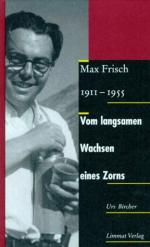|
This section contains 3,918 words (approx. 14 pages at 300 words per page) |

|
SOURCE: Blair, Rhonda L. “Archetypal Imagery in Max Frisch's Homo faber: The Wise Old Man and the Shadow.” Germanic Review 59, no. 3 (summer 1984): 104-08.
In the following essay, Blair examines Frisch's utilization of two archetypes—the Wise Old Man and the Shadow—in Homo faber and relates it to C. G. Jung's psychology and use of imagery.
Max Frisch's familiarity with the work of C. G. Jung and his use of images related to Jungian ideas have increasingly received critical attention.1 In particular, Jean Quenon's study of Frisch's plays explores the self-realization proc ess of the dramatic characters with reference to Jungian psychology. The present essay, however, is concerned less with psychology per se and more with the archetypal imagery employed by Frisch in the novel Homo faber: Ein Bericht (1957).2 The imagery which adds an overall richness to the novel and elevates Faber's search for self-discovery from the plane...
|
This section contains 3,918 words (approx. 14 pages at 300 words per page) |

|


